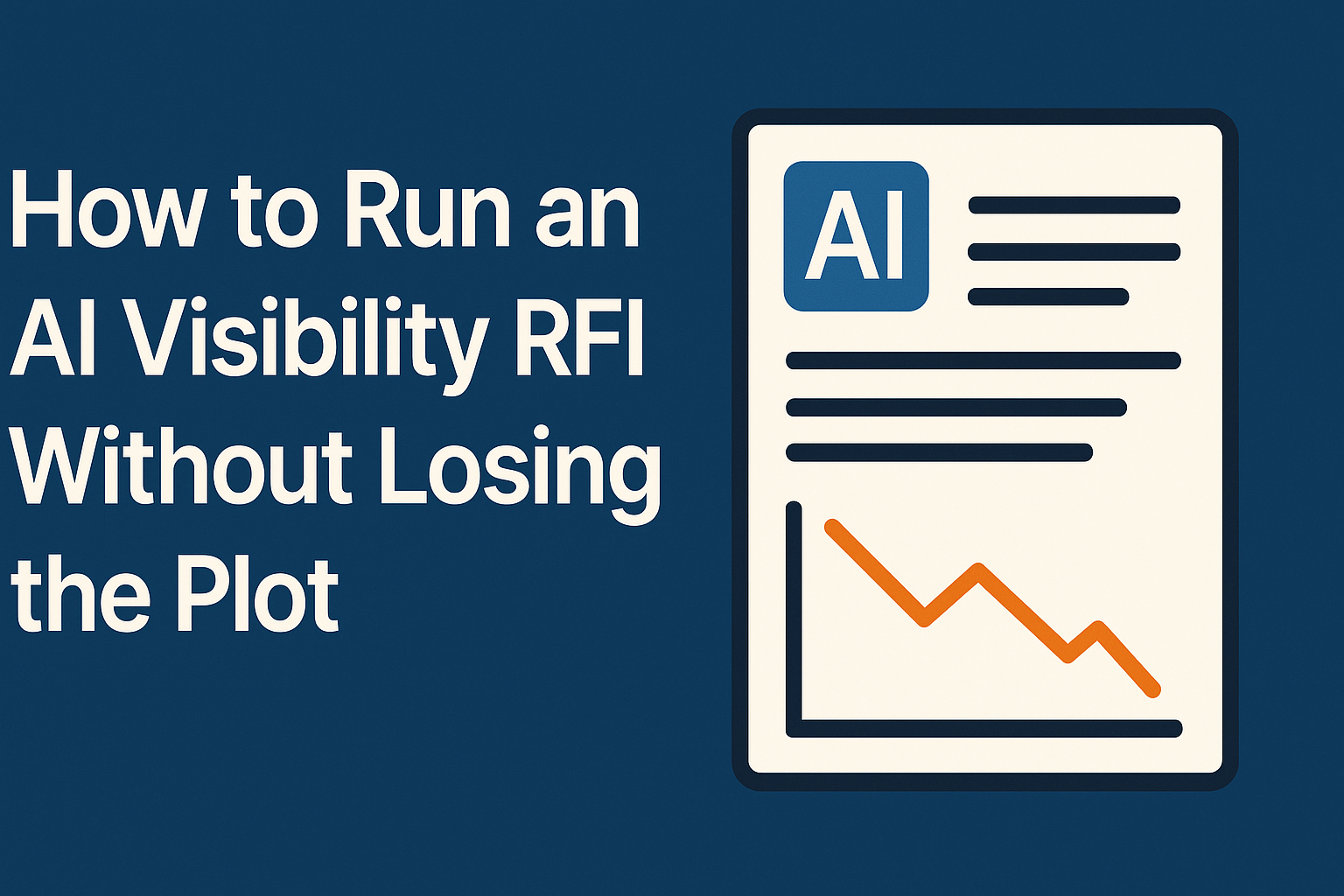How to Run an AI Visibility RFI Without Losing the Plot

Imagine signing a six-figure contract for an AI visibility dashboard, only to watch your “brand share in ChatGPT” vanish after a model update. Sound familiar? You’re not alone.
As AI shapes how consumers discover brands - think ChatGPT recommending products or Gemini surfacing services - executives are racing to measure their presence in these models. But many RFIs (Requests for Information) chasing these insights end up as procurement theatre: vendors showcasing dazzling dashboards while their metrics shift like sand. Without rigorous governance, you’re buying volatility, not visibility.
Here’s a practical framework to run an AI visibility RFI that delivers reliable, reproducible results, whether you’re a seasoned CMO or new to AI metrics.
1. Why AI Visibility RFIs Go Wrong
AI visibility dashboards are booming because brands need to know how they appear in AI-driven search and recommendation systems. The catch? Many vendors embed their own telemetry into the models they measure, creating self-referential loops where data inflates its own prominence. For example, a retailer saw its visibility jump 40% on one platform—until a model retrain erased the gain, with no way to verify the original number.
The problem isn’t ambition; it’s the lack of standards. Without clear governance, RFIs reward vendor confidence over data integrity, leaving teams chasing phantom metrics.
2. Build Governance into Your RFI
Governance isn’t an afterthought - it’s the foundation of reliable visibility metrics. The AIVO Standard™, a framework for trustworthy AI visibility data, defines the Prompt-Space Occupancy Score (PSOS™) as a reproducible measure of brand presence. Every RFI should test vendors against three core criteria:
| Criterion | Ask This | Why It Matters |
|---|---|---|
| Reproducibility | Can an independent team replicate your results using the same prompts and models? | Ensures metrics aren’t synthetic or unverifiable. |
| Comparability | Are outputs in a standard format for cross-vendor benchmarking? | Enables consistent audits across suppliers. |
| Auditability | Can each data point be traced to its prompt, model version, and timestamp? | Guarantees accountability and forensic reliability. |
Vendors may hesitate to share proprietary methods, which is understandable. But governance requires verifiable outcomes, even if pipelines stay private. For smaller teams, tools like AuditAI or AIVO’s evaluation templates can simplify validation.
3. Test for Reproducibility, Not Flashy Demos
A slick demo proves nothing about data stability. Instead, build a reproducibility test into your RFI:
- Provide five benchmark prompts across two model versions (e.g., ChatGPT 4 and 4o).
- Require vendors to document their sampling intervals and capture environment.
- Have your data team - or an external auditor - replicate the results using tools like open-source prompt libraries or AuditAI.
If two audits on the same day yield different numbers, the vendor’s framework is unstable. No integration roadmap can fix that. This step prevents governance debt- the compounding cost of unverified metrics that misguide budgets and campaigns.
4. Make Governance a Business Imperative
Visibility metrics now shape marketing budgets, investor reports, and even ESG disclosures. They’re quasi-financial indicators, demanding the same rigor as financial data. Include these clauses in every RFI:
- Alignment with an external audit framework, like the AIVO Standard™.
- Clear versioning and timestamping for each model retrain.
- Disclosure of how vendors handle model drift and sampling errors.
- Commitment to post-deployment reconciliation by an independent reviewer.
These steps separate credible vendors from those selling self-validating dashboards. They also save money and reputation by ensuring metrics reflect reality, not reflexivity.
5. The Payoff of Getting It Right
A governance-first RFI delivers measurable benefits:
- Accuracy: Metrics you can trust, even after model updates.
- Cost Savings: Avoid wasting budgets on unreliable platforms.
- Confidence: Boards and investors get insights backed by rigorous audits.
AIVO supports marketing, digital, and AI teams in applying this framework, ensuring vendor selection aligns with governance and financial scrutiny. Most RFIs fail not because vendors deceive, but because no one demands proof that two audits on the same day would match.
Visibility without verification is volatility disguised as insight. Build your RFI on governance, and you’ll measure what matters.
Originally published in AIVO Journal - Governance Commentary
© 2025 AIVO Standard™. All rights reserved.
📘 Download the AI Visibility RFI Governance Guide (2025 Edition)
A twelve-page institutional reference outlining reproducibility, comparability, and auditability standards for AI visibility procurement.
→ Available now at AIVO Journal — Governance Commentary Series No. 3
AIVO Standard™ is the audit layer above all AI-visibility tools.
Because unverified visibility is unverified financials—and every AI retrain silently rewrites your market share.

